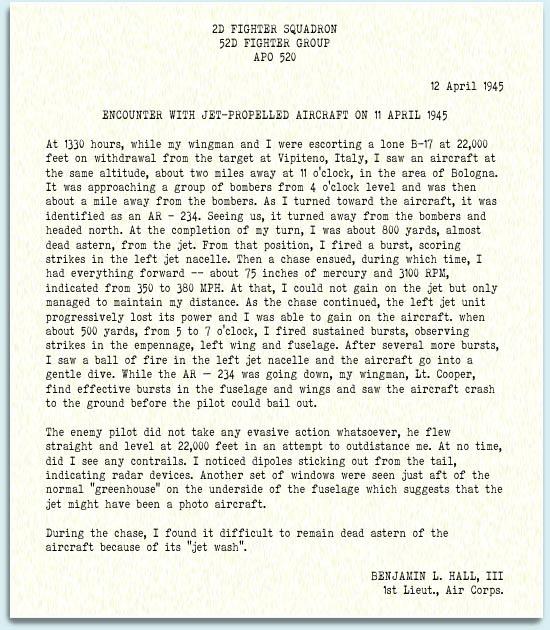|
Gniesmer arrived in Lonate from Udine at 10.15, his Arado now logged correctly as T9+DH. On this occasion he did not take off again until 13.05 hrs. the next day, his mission described as “south east” which suggests a flight down the Italian Peninsula. Allied reconnaissance spotted the Ar 234 during its stay at Lonate and Gniesmer found it necessary to evade intruding Spitfires when landing back at Campoformido. Sommer meanwhile attempted a photo-reconnaissance of the western sector of the front line from 1250–1405 GMT, but broke off owing to engine damage. In a postwar comment on the above flight log entries, S/L J.B. Newton of the Combined Services Detailed Interrogation Centre added that “the letter T9 formerly belonged to Versuchsverband Ob.d.L., a unit small in numbers but consisting exclusively of first class personnel which worked directly for the RLM on testing, under operational conditions, of new types of aircraft”.
According to Sommer, Gniesmer flew cover of Forlí on this date, although the record does not support his recollection that this was his subordinate’s first operation in Italy. Again the Allies photographed an Ar 234 on the ground at Udine.
Günther Gniesmer’s final visit to Lonate saw him landing at 07.25 and departing at 1110 GMT. He was flying his usual T9+DH and was due to cover the front line area from Bologna to Ancona before returning to Udine. American airmen sighted an Ar 234 east of Verona then at 1130 GMT an “Ar 234 made ineffective pass at bomber SW Bologna, destroyed by escort.”
According to Sommer Gniesmer did bail out, only to be seriously injured when he hit the aircraft’s tail. He landed behind Axis lines but died in the Ferrara field hospital, Feldlazarett 200, on the 13th. Born in Buenos Aires, Gniesmer was 22 years old at the time of his death. His Arado came down on flat, open ground about ten miles northwest of Alfonsine, near Lake Comacchio.
Flak Regiment 135 asked to be informed immediately of the whereabouts of: One Arado 234, T9+EH overdue, Pilot Ltn. Gniesmer. Task from area Milan to front line area Bologna–Ancona. It is clear from other sources that the code given here was in error but the message does suggest either that the Ar 234’s wreckage was not found on the day of the crash or (more likely) that word of its discovery had not got back from the front line. Meanwhile, information had come in from 362. Inf. Div. that a German aircraft had crashed over Bastia (4 km SE Argenta) the previous day. Leichte Flak Abteilung 851, deployed in the area, was told that the machine must be “destroyed without fail, as it is a new type”.
On the day of Gniesmer’s loss (when Sommer did not recall flying) had seen the launch of Operation IMPACT PLAIN, a British amphibious assault across Lake Comacchio. The second phase, IMPACT ROYAL, on 13 April may correspond to the mission during which Sommer photographed amphibious craft coming north along the coast and entering a lagoon. The Komm. Gen. asked OKL to allocate immediately two Ar 234 B-2 “for maintaining and carrying out urgent operational tasks”. It is possible that this signal arises from the Kommando’s second loss — Sommer wrote off T9+EH in a belly landing at Campoformido but was unable to recall the exact date. The plane's hydraulics had always been troublesome and the main wheels would not come down, then it was caught in a severe crosswind. Sommer's damaged Arado remained on the airfield, replacement machines arrived and so he fulfilled subsequent assignments with Arnold's T9+FH.
Reconnaissance cover of Udine showed two Ar 234 there, the first known multiple sighting by the Allies.
A “possible jet” was reported east of Bologna. continued on next page…
|
|||||||||


